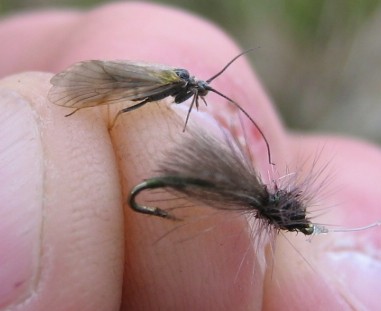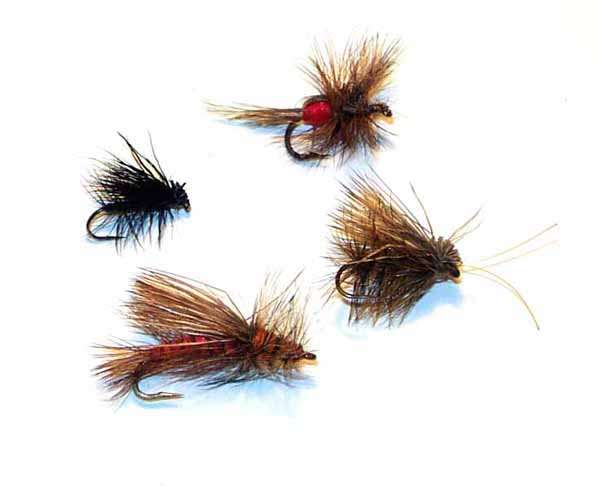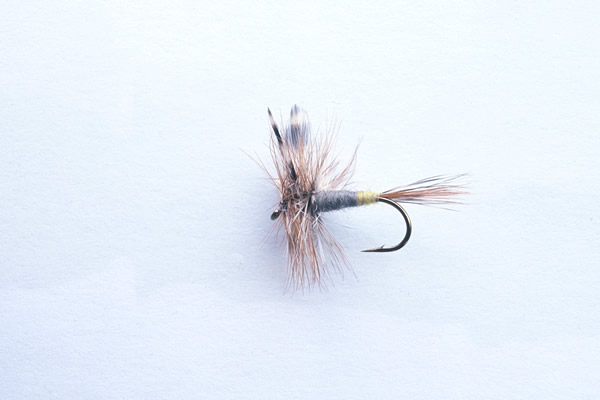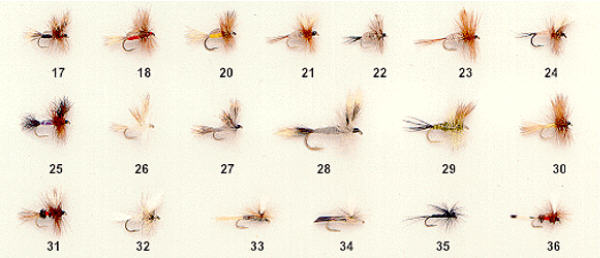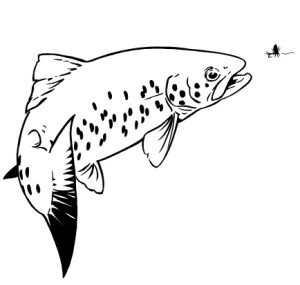|
DRY FLIESCatch 'em on the "dry"
Everything You Always Wanted to Know To a dry fly fisherman, the thrill of a surface water hit from a lunker trout cannot be topped. The only thing that comes close is a cold brew and a hot bratwurst. Fishing off the top of the water is done with a type of fly called a dry fly, so here is everything you always wanted to know about them but were afraid to ask.
History It is not distinctly clear who invented the idea of dry flies, but it does originate in merry old England. A publication called The Field first coined the words "dry fly" in 1853. By the end of the next year, a Cheltenham company called Foster's was selling the flies (they were also called trout flies) openly and doing well. If any singular human being was the father of dry tied flies, it would have to be James Ogden around this same time period. It is certain that he used floating fly rigs, but so had a number of other people. Nobody else stepped up to claim the invention, so Ogden grabbed the bull by the horns.
Now came the transforming of the floating fly rig in the 1840's and 1850's. Ogden and Foster were involved directly in the transforming of the floating fly to the hackled fly between 1840 and 1850. This is believable because it matches precisely with the appearance of the false cast in early 1850. Strangely enough, the first reported trout caught on a "dry" didn't come until 1888. In any event, this type of fly has made itself very well known and accepted by seasoned anglers worldwide as effective bait to cast in moving waters. When to make your fly dry Trout will take to feeding at different times of day. If it is hot outside, they must stay near the bottom where their "air conditioning" is better. You may catch a lunker or two surfacing in shaded areas during the daytime when the sun is high. In either case, the thing to do is match the hatch. This means to tie on a fly that resembles what the river or stream is producing. The first thing to understand is that floating flies are winged insects that are either nearing or at the end of their life cycle. They weaken and fall to the water surface and take a nice float trip down the old stream. The fish will see this and recognize that dinner is being served easily and will begin taking the floaters as food. Since surface insects constitute about 25 percent of the trout's diet, this is a pretty good bet. Don't worry about knowing when to fish the floater, you WILL know. How will you know? Very simple and I am SO glad you asked.
All you have to do is stand in your spot, whether it's in the water or on a rock, and watch the water. Look at what's passing by on top. Then look upstream and watch the surface for feeding activity. If you see many little "blurps", it's time to keep that fly dry and float an offering to the god of the stream. Once you have done this, reach into the water and snag one of whatever the stream is offering up in the hatch. Look in your massive arsenal of pre-tied flies and pick one that closest resembles what you have taken from the water. Now you have all the information you need to take on the giants out there. You know what they are eating and where they are eating it. Trust me, if you cast it, they will bite. At times, for whatever finicky reasons they may have, trout may decide NOT to feed on the top floaters just wafting by lazily on the current. In these cases, you should rely on middle range to bottom techniques using scuds or some aquatic offering. Maybe a wet fly (a fly that sinks as opposed to floating on top) may be in the mix. You will want to cast to the areas that have been physically active. Remember, you have watched and learned and you know where the trout are at. Work a casting pattern that works their area completely. The best way to do this is to cast upstream from the hot spot and allow the current to take the fly into the red zone. You are in the trout's domain and he is NOT stupid. Do not take him for granted or he will skunk you every time. Be patient and if you don't get a strike on the first pass, go at it again. You may even have to try a couple of different color combos. You definitely want to go with what is naturally occurring. For instance, if the current hatch is a yellow caddis fly with purple wings, you won’t get anywhere with a green mayfly and transparent wings. What you offer has to look like what Mother Nature is giving up.
Keeping your floater fly on the top One of the things that trouble fly anglers is keeping the fly on top of the water. One way to knock that problem out right away is to use a floatant on the fly you are using as well as on the line. Both the flies and fishing line tend to sink after a while in the water. This spray material makes your offering more buoyant so that doesn't happen. Dry Fly Patterns The truth about flies is that there are never enough in your tackle box. Patterns come on many varieties like midge, dry, CDC, salmon, caddis, mayfly, jig and terrestrial. There are more but these are just a sampling of the available patterns that are being tied both industrially and in personal home workshops. What pattern works best goes back to the "MATCH THE HATCH" mentality. Tie on what looks like the natural river offering and keep a tight grip on your rod handle. If all else fails, try “stimulators” or “streamers”. They don’t really match anything but you can’t use a hand grenade. Go
fly fishing
whenever possible. Keep your creel high and your fly dry!
Return from Dry Flies to Fly Fishing Flies
|





